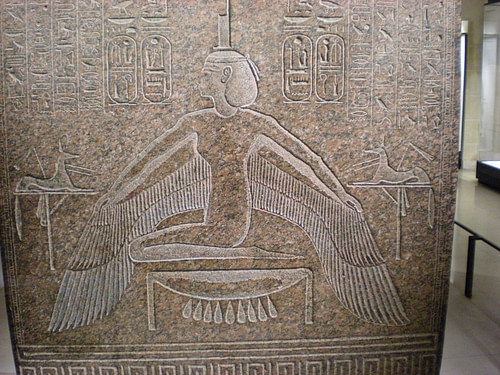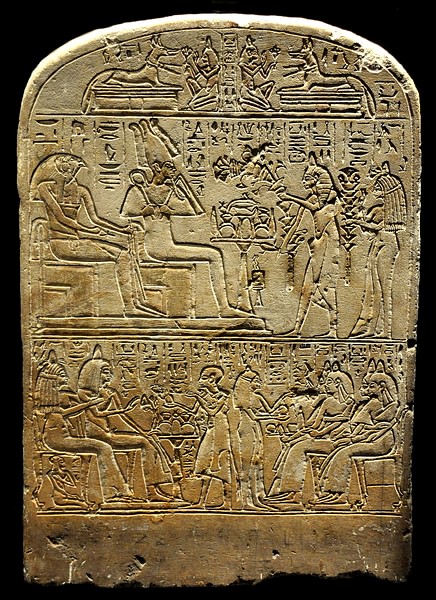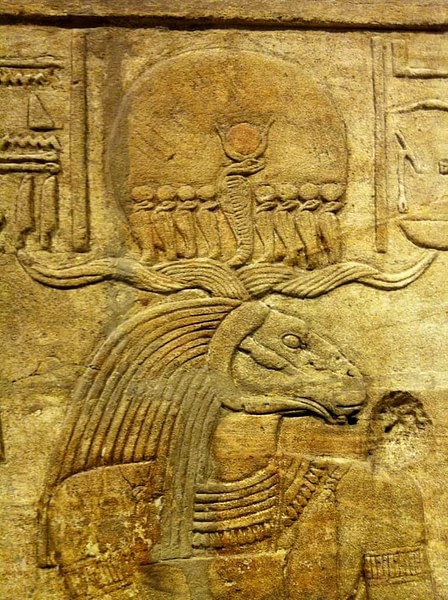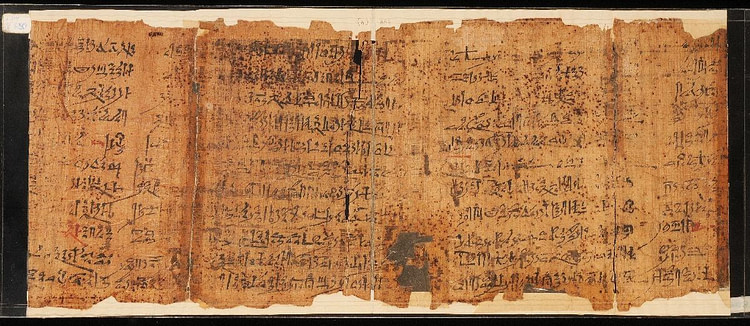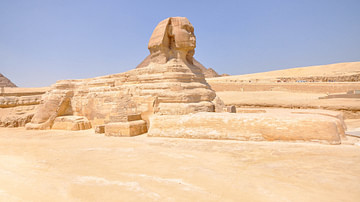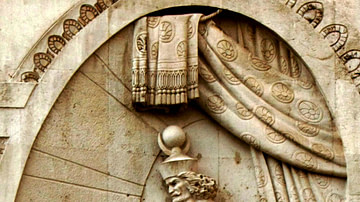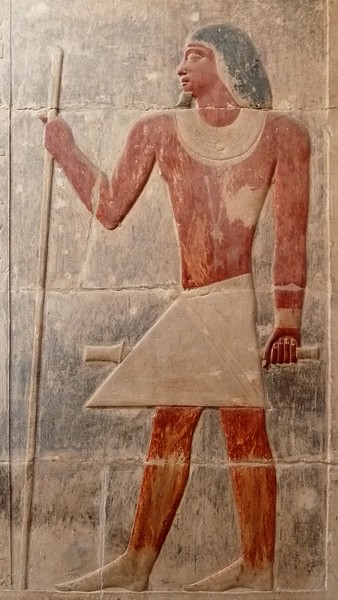
Ancient Egyptian culture flourished through adherence to tradition and their legal system followed this same paradigm. Basic laws and legal proscriptions were in place in Egypt as early as the Predynastic Period (c. 6000- c. 3150 BCE) and would continue, and develop, until Egypt was annexed by Rome in 30 BCE. Egyptian law was based on the central cultural value of ma'at (harmony) which had been instituted at the beginning of time by the gods. In order to be at peace with oneself, one's community, and the gods, all one had to do was live a life of consideration, mindfulness, and balance in accordance with ma'at.
Humans are not always considerate or mindful, however, and history illustrates well how poorly they maintain balance; and so laws were created to encourage people on the desired path. Since the law was founded on so simple a divine principle, and since it seemed clear that adhering to that principle was beneficial to all, transgressors were often punished severely. Although there are certainly cases of leniency shown to criminal suspects, the operative legal opinion was that one was guilty until proven innocent since, otherwise, one would not have been accused in the first place.
The law in ancient Egypt functioned just as it does in any country today: there was a set of agreed-upon rules which had been formulated by men who were considered experts in the field, a judicial system which weighed evidence of infractions of those rules, and police officers who enforced those rules and brought transgressors to justice.
No Egyptian law code has as of yet been found which corresponds to Mesopotamian documents like the Code of Ur-Nammu or Hammurabi's Code but it is clear that one must have existed because precedent in deciding legal cases was set by the time of the Early Dynastic Period (c. 3150- c. 2613 BCE) as evidenced by their established use in the early years of the Old Kingdom (c. 2613-2181 BCE). These precedents were then used in judging cases during the Middle Kingdom (2040-1782 BCE) and onward through the rest of the country's history.
Structure of the Legal System
Even if the specifics of their law code are unknown, the principles it derived from are clear. Egyptologist Rosalie David comments on this:
Compared with other ancient civilizations, Egyptian law has yielded little evidence for its institutions. It was, however, clearly governed by religious principles: Law was believed to have been handed down to mankind by the gods on the First Occasion (the moment of creation), and the gods were held responsible for establishing and perpetuating the law. (93).
At the top of the judicial hierarchy was the king, the representative of the gods and their divine justice, and just beneath him was his vizier. The Egyptian vizier had many responsibilities and one of them was the practical administration of justice. The vizier heard court cases himself but also appointed lower magistrates and, sometimes, involved himself with local courts if circumstances required it.
The legal system formed regionally at first, in the individual districts (called nomes) and was presided over by the governor (nomarch) and his steward. During the Old Kingdom, these regional courts were firmly consolidated under the king's vizier but, as David notes, the judicial system in some form had existed previously:
Inscriptions in tombs and on stelae and papyri, which provide the earliest extant legal transactions, can be dated to the Old Kingdom. They indicate that the legal system was well developed by this date and suggest that there must have been a long period of experimentation beforehand. Egyptian law ranks with Sumerian as the world's oldest surviving legal system and its complexity and state of development are on a level with ancient Greek and medieval law. (93).
The earliest form of the law at the regional level was probably quite simple but became more bureaucratic during the Old Kingdom. Even so, at this time, judges were often priests who conferred with their god to reach a verdict rather than weighing the evidence and listening to testimonies.
It was only during the Middle Kingdom that professional judges were installed to preside over courts and the judicial system operated on a more rational, recognizable paradigm. This period also saw the creation of the first professional police force which enforced the law, took suspects into custody, and testified in court.
Administration of Law
The courts which administered the law were the seru (a group of elders in a rural community), the kenbet (a court on the regional and national level) and the djadjat (the imperial court). If a crime were committed in a village and the seru could not reach a verdict the case would go up to the kenbet and then possibly the djadjat but this seems a rare occurrence. Usually, whatever happened in a village was handled by the seru of that town. The kenbet is thought to have been the body which made the laws and meted out punishments on a regional (district) level as well as a national level and the djadjat made the final ruling on whether a law was legal and binding in accordance with ma'at.
In general, ancient Egyptians seem to have been law-abiding citizens throughout most of the culture's history but, still, there were arguments concerning land and water rights and disputes over ownership of livestock or the rights to a certain hereditary job or title. Bunson notes how:
Egyptians waited in line each day to give the judges their testimony or their petitions. The decisions concerning such matters were based on traditional legal practices, although there must have been written codes available for study. (145).
The judges Bunson references were the members of the kenbet and every capital of each district had one in session daily.
The vizier was ultimately the supreme judge but most court cases were handled by lower magistrates. Many of the cases heard involved disputes over property following the death of the patriarch or matriarch of a family. There were no wills in ancient Egypt but a person could write out a transfer document making clear who should receive which portions of property or valuables. Then as now, however, these documents were often disputed by family members who took each other to court.
There were also instances of domestic abuse, divorce, and infidelity. Women could sue for divorce as easily as men and could also bring suits regarding land sales and business arrangements. Cases involving infidelity were filed by both sexes and the punishment for the guilty was severe.
Crime & Punishment
Infidelity was considered a serious offense only if the individuals involved made it one. A husband whose wife had an affair could forgive her and let the matter go or he could prosecute. If he chose to take his wife to court, and she were found guilty, the punishment could be divorce and amputation of her nose or death by burning. An unfaithful husband who was prosecuted by his wife could receive up to 1,000 blows but did not face the death penalty. As the nuclear family was considered the basis for a stable community, adultery was a serious offense but, again, only if those involved brought it to the attention of the authorities or, in some cases, if a neighbor informed against them.
This same model seems to have been followed in other areas as well. It was the duty of the family to provide tomb offerings for their deceased loved ones and, if they did not have the time, they could hire someone else to do it. These replacements were known as ka-priests who, for a price, would provide daily food and drink offerings at a tomb. As long as the family kept paying, a ka-priest was supposed to keep his position and even hand it down to his son. If a family stopped paying, the priest could simply move on or could sue the family for the continuance of the position and back pay. A family might also take a ka-priest to court for not fulfilling his sworn duties.
There were no lawyers in ancient Egypt. A suspect was interrogated by the police and the judge in court and witnesses were brought in to testify for or against the accused. Since the prevailing belief was that a person who had been charged was guilty until proven innocent, witnesses were often beaten to make sure they were telling the truth. Once one had been charged with a crime, even if one were finally found innocent, one's name was kept on record as having been a suspect. As such, public disgrace seems to have been as great a deterrent as any other punishment. Even if one were completely exonerated of all wrong-doing, one would still be known in one's community as a former suspect.
It was because of this that people's testimony regarding one's character – as well as one's alibi – was so important and why false witnesses were treated so harshly. One might falsely accuse a neighbor of infidelity for any number of personal reasons and, even if the accused were found innocent, they would still be disgraced.
A false charge, therefore, was considered a grave offense and not only because it disgraced an innocent citizen but because it called into question the efficacy of the law. If an innocent person could be punished by a system which claimed divine origin then either the system was wrong or the gods were, and the authorities were not interested in having people debate those points. A false witness, therefore, was dealt with harshly: anyone who purposefully and knowingly lied to the court about a crime could expect any kind of punishment from amputation to death by drowning. Because of this situation, on the whole it seems every attempt was made to determine the guilt of a suspect and mete out the proper punishment.
In general, if the crime was serious – such as rape, murder, theft on a large scale, or tomb robbing – the penalty was death or disfigurement. Men found guilty of rape were castrated or had their penis amputated. Murderers were beaten and then fed to crocodiles, burned to death, or executed in other unpleasant ways. Thieves usually suffered amputation of the nose, hands, or feet. David notes the punishment for those who killed members of their own family:
Children who killed their parents underwent an ordeal in which pieces of their flesh were cut out with reeds before they were placed on a bed of thorns and burnt alive. However, parents who killed their children were not put to death but were instead forced to hold the dead child's body for three days and nights. (94).
Decline of the System
The problem of false witnesses was not so prevalent in the early centuries of the civilization but became more frequent with the decline of the Egyptian Empire and a loss of faith in the concepts which had regulated Egyptian society and culture for thousands of years. During the latter part of the reign of Ramesses III (1186-1155 BCE), belief in the primacy of ma'at began to break down when the pharaoh seemed less concerned with the welfare of his people than with his life at court.
The tomb worker's strike at Deir el-Medina in 1159 BCE is the clearest evidence of the fracturing of a bureaucracy which had served the society for millennia. These workers were regularly paid in grain, beer, and other necessary items for which they relied on the government since they lived – at the government's discretion – in an isolated valley outside of Thebes. When the wages failed to arrive, the workers went on strike and the officials were unable to handle the situation.
The pharaoh had failed to uphold and maintain ma'at and this affected everyone from the top down in the hierarchy of Egyptian social structure. Tomb robbing became more prevalent – as did false witnesses – and even law enforcement became corrupt. The testimony of a police officer was considered completely reliable but police during the latter part of the New Kingdom could accuse someone, have them sentenced, and then take whatever they wanted from the suspect's possessions.
A letter from the reign of Ramesses XI (1107-1077 BCE) discusses two policemen who are accused as false witnesses. The author of the letter, a general in the army, instructs the recipient to have the two officers brought to his house where they will be examined and, if found guilty, will be drowned in baskets in the River Nile. The general, however, is careful to remind the letter's recipient to drown the officers at night and to make sure they “do not let anybody in the land find out” (van de Mieroop, 257). This cautionary warning, and others like it, was made to try to cover up the corruption of the police and other officials. No amount of caution or cover-up could help, however, because the corruption was so widespread.
At this time, too, tomb robbers who were caught and convicted could buy their way out of jail and sentencing by bribing a police officer, bailiff, or court scribe with some part of the treasure they had stolen and then return to robbing tombs. Judges who were supposed to be handing down sentences might instead serve as fences for stolen goods. Viziers who were supposed to embody and uphold justice and balance were busy enriching themselves at the expense of others. As stated before, the pharaoh, who was supposed to be maintaining the foundation of his entire civilization, was more interested at this time in his own comfort and ego gratification than the responsibilities of his office.
Further, the final years of the New Kingdom and the succeeding era of the Third Intermediate Period (c. 1069-525 BCE) saw a return of the legal system to the Old Kingdom methodology of consulting a god regarding innocence or guilt. The Cult of Amun, regularly the most powerful in Egypt, had by this time almost eclipsed the authority of the throne. During the Third Intermediate Period, suspects would be brought before a statue of Amun and the god would render a verdict. This was accomplished by a priest either inside or behind the statue moving it one way or another to give an answer. This method of administering justice allowed for numerous abuses, obviously, since cases were now being heard by a priest hiding in a statue rather than an officially appointed judge in a court of law.
Although Egypt would see some bright moments in the return to law and order throughout the later periods, the legal system would never again function as efficiently as it had during the periods up through the New Kingdom. The Ptolemaic Dynasty (323-30 BCE) revived the practices and policies of New Kingdom administrative justice – as they did with many aspects of that period – but these initiatives did not last far beyond the first two rulers. The latter part of the Ptolemaic Dynasty is simply one long, slow, decline into chaos until the country was annexed by Rome in 30 BCE and became another province of their empire.
